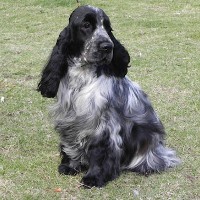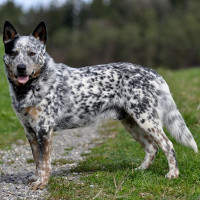Appearance of the Blue Spaniel
|
| A Blue Spaniel generally resembles a small Australian Cattle Dog with Cocker ears and coat. They have a compact, athletic build. Size depends on whether the Australian Cattle Dog is crossed with an American or English Cocker Spaniel. In any case, they are generally medium-sized. The average weight is 12.5 to 20.5 kilos and the average height is 38 to 51 centimeters. Their coat is blue (marbled or spotted) or black and white with ochre markings. Blues Spaniels retain the soft, wavy, medium coat of English Cocker Spaniels. They have an alert, intelligent expression, with soft ears, a scissor bite, a dark nose and oval eyes that are usually dark brown or hazel. Their tails are of medium length and tapered, while the legs are round with elastic pads for running. |
Temperament of the Blue Spaniel
|
| Blues Spaniels are known to be happy, friendly dogs with occasional aggressive, hunting tendencies. These tendencies are triggered when Blues Spaniels are around groups of dogs or small animals. Blues Spaniels bark occasionally and are known to be sensitive to environmental and routine changes, as well as to the aggressive behavior of others. Fortunately, the breed also responds well to obedience training, given its high level of intelligence and willingness to please its owner. Otherwise, Blues Spaniels can be very playful and eager to participate in games with their owners and most other dogs. Because both parent breeds require physical and mental stimulation, Blues Spaniels need to be exercised and entertained regularly to stay satisfied and healthy. The Blue Spaniel is more like its English Cocker Spaniel ancestry in that it is extremely people-oriented, making it an affectionate and loyal family dog that loves human attention. |
Needs and activities of the Blue Spaniel
|
| Blue Spaniels come from two very energetic, inquisitive breeds. As a result, they require constant, daily exercise. Blues Spaniels should have at least one moderate to long walk a day, combined with vigorous play with other dogs or retrieving games with people. Blues Spaniels thrive in cool, temperate environments. They'll do well in warm environments if they're not over-exercised in the heat. Blues Spaniels will be happiest in a suburban or rural home with a large yard in which they can play. Both parent breeds have strong impulses to roam, so Blues Spaniels should be closely supervised if off-leash or in an area that isn't well fenced. Although Blues Spaniels like to be outdoors, they are primarily indoor pets who appreciate downtime with their owners and family. |
Maintenance of the Blue Spaniel
|
| Blues Spaniels are moderate excretors and, as a result, require a moderate level of regular grooming. They are not completely hypoallergenic, but produce fewer allergens due to the hair-like coat on their Spaniel side. Owners can reduce shedding and matting by brushing 1-2 times a week and giving the Blue Spaniel its monthly bath. Owners should pay particular attention to cleaning the Blue Spaniel's large, soft ear with each wash. Like all dog breeds, Blues Spaniels should have their teeth brushed daily and their nails trimmed 1-2 times a month to prevent painful overgrowth. Trimming around the head, ears, tail and feet is recommended. |









 English (United Kingdom)
English (United Kingdom)